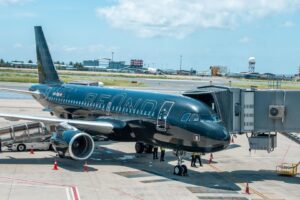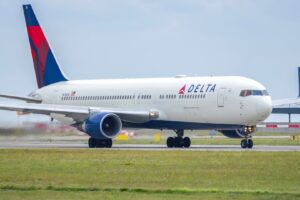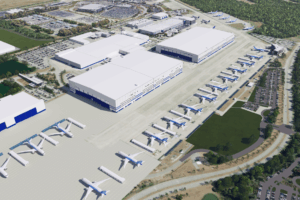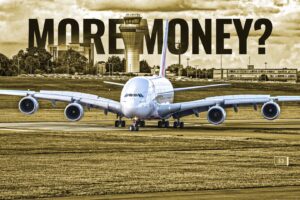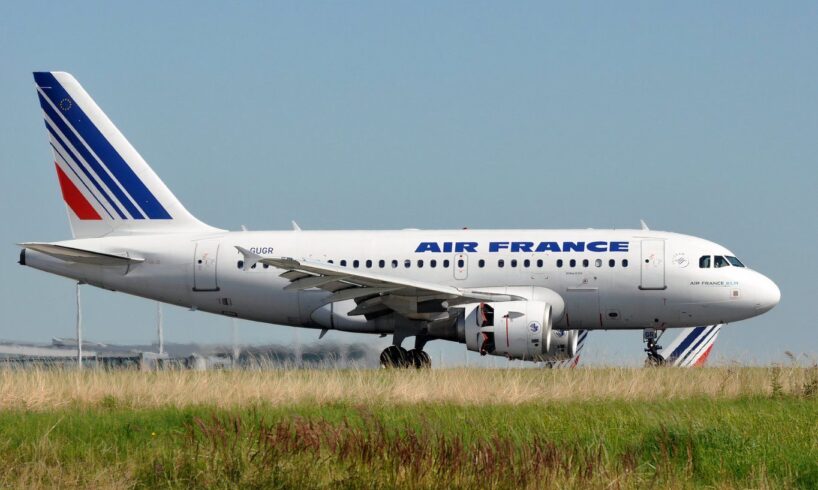
The Airbus A318 has never been popular, largely due to its poor economics compared to larger alternative equipment. According to ch-aviation, just 80 aircraft were built. Following TAROM’s withdrawal of the so-called baby bus in November 2024, only Air France continues to use it on a scheduled passenger basis. Various other operators continue to fly it in niche roles.
Length
103 ft 2 in (31.4 m)
Wingspan
111 ft 11 in (34.1 m)
Height
41 ft 2 in (12.6 m)
Using Cirium Diio data to examine every A318 flight in July and August shows that France’s flag carrier plans just two UK routes: Nice to London Heathrow and Paris CDG to Heathrow. However, other airport pairs may see it on a substitution basis.
Air France’s 2 UK A318 Routes: July & August
Photo: GCMap
In the two peak summer months, virtually all A318’s UK services revolve around Nice to Heathrow. Air France’s flights on the airport pair—which have been part of its network since 2022—have only been partly operated by the A318. After last seeing the type on June 28, the baby bus will return on July 14. It will coexist with the A319 and A320ceo on the daily offering.
The A318 is scheduled to operate just one in 370 Air France flights between Paris CDG and Heathrow. Virtually all services are on the A220-300, which will eventually replace it. On Sunday, July 20, AF1680 will arrive at Europe’s busiest airport at 08:00. Some 55 minutes later, it’ll operate AF7551 to the Côte d’Azur.
A318-Operated Route
A318 Operations (July & August)
Schedule To Heathrow; Local Times
Schedule From Heathrow; Local Times
Nice to Heathrow
July 14, 20, 26, August 2-5, 10, 12, 17, 19, 24, 26, and 31
06:55-07:55
08:55-12:00
Paris CDG to Heathrow
July 20 and 30 (only on July 30 from the UK)
07:35-08:00 (July 20), 18:15-18:35 (July 30)
19:45-22:00 (July 30; no flight back to France on July 20)
Air France Now Has 6 A318s
Photo: Croatorum I Shutterstock
According to ch-aviation, Air France has six A318s, all of which are in service. They average 18.7 years, and are among the carrier’s oldest narrowbodies. As most are owned by Air France, they’re paid off. Of course, unlike newer equipment of the same size, they suffer from higher fuel burn and maintenance requirements. But the fundamental problem is their small size and, therefore, higher seat-mile costs.
With only 131 seats (18 in business and 113 in economy), it is the smallest aircraft in the SkyTeam member’s mainline fleet. Twelve other frames have been retired from its fleet and are now used by other carriers, scrapped, or stored.
They are in the process of being replaced by the 148-seat Airbus A220-300. While the A220 will be much more expensive ownership-wise, meaning it’ll need to be used more intensively, the seat-mile cost from being larger and from far lower fuel consumption, etc., means it’ll be a much more competitive machine.
Related
London Stansted Gets Turkish Airlines As The Carrier’s UK Capital Flights Rise To Record 14 Daily
The carrier will now fly to Gatwick, Heathrow, and Stansted.
Why Was The A318 So Unpopular?
Photo: Laurent Errera | Wikimedia Commons
The unpopularity of the A318 is largely due to its relatively poor economics. It is too heavy for its capacity, meaning higher and less attractive operating and seat-mile costs than alternative aircraft. For example, while the A318’s maximum takeoff weight is roughly the same as the A220-300’s, the A220 has nearly 14% more seats in Air France’s configuration.
The A220’s seat-mile costs are lower, while enabling revenue-generating opportunities from having more seats to sell (if they are needed). This is precisely the same situation with lots of other equipment (e.g., the 737-600 versus the 737-700, the 737-700 versus the 737-800, the A319 versus the A320, etc.)
These things (and more) made the A318 less appealing in a normal commercial sense, but this is just one part of the story. It found a niche, particularly operating from very short runways, such as at Rio de Janeiro’s Santos Dumont (4,341 feet; 1,323 meters) with Avianca Brazil. It is also certified to perform the steep approach to London City’s short runway (4,949 feet; 1,508 meters). British Airways deployed it to New York JFK in an all-business layout (stopping in Shannon to refuel on the outbound leg).


